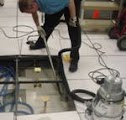Audio/Visual technologies are dramatically improving the modern workplace. While traditional offices are changing rapidly, with open plan environments, huddle rooms, and mobile/remote working, these challenges must be met with technology in order for these spaces to continue to work effectively. This is especially true when connecting people in different geographies.
The way we work has evolved over time, and the technology necessarily should also evolve. Intuitive collaboration tools are transforming the way teams work. An understanding of how to apply current workplace technologies to meeting spaces and environments of all sizes will ensure your enterprise can remain productive and efficient, while eliminating the connection headaches of the past.
The way we work has evolved over time, and the technology necessarily should also evolve. Intuitive collaboration tools are transforming the way teams work. An understanding of how to apply current workplace technologies to meeting spaces and environments of all sizes will ensure your enterprise can remain productive and efficient, while eliminating the connection headaches of the past.
Here are the Top 6 Ways A/V Can Improve Your Business:
- Fluent Communications from Any Device
Users no longer have to draw a distinction between an audio conference, video conference and/or web presentation. In addition, customers don’t need to have separate providers/accounts for each. Instead, products like Zoom or Microsoft Teams allow call attendees to join the call from whatever device they have available. Office users can join from a conference room or from their computer. Mobile users can join on their smartphone or tablet. All participants can be on video and share/view content on the call – all using a single service; no more siloed communications.
- Start Meetings On Time
By inviting the room itself to the meeting along with the remote attendees, the meeting is sure to start on time – and with just a touch of a button. Every aspect of the room can be accurately controlled, including, but not limited to: lighting, multimedia integration, email schedules, and meeting and presentation control.
- No More Worrying About Having the Right Connector
BYOD wireless content sharing allows anyone to share content from any device (PC, Mac, iOS, Android, etc.). No more dongles, and no more worrying about finding the “right” cable or adapter.
- Extend Branding & Corporate Communication Into Common Areas & Conference Rooms
Effective use of digital signage ensures the timely delivery of information to all people, be they clients, employees, or vendors. This eliminates the need for the labor and expense of printing posters and static signage.
- End Conference Room Squatting
Conference room scheduling panels installed at the room entrance allow rooms to be scheduled in advance, and/or booked ad hoc. The schedule for each room is easily displayed with the touch of a button. Room analytics are also available to measure usage and occupancy to provide actionable data on resource utilization.
- A/V is Not Just for Auditoriums, Large Rooms, and Board Rooms A/V systems that enable calls, as well as share/view content, have become very affordable and easy to implement and use. This makes them very effective solutions for both small & medium spaces, too, which is where most of the real day-to-day work and collaboration happen.






















